Client collaboration can sometimes turn into a real hassle. Feedback gets lost in never-ending email threads during the constant back-and-forth between content editing and messaging tools. We’ve all been there.
Dedicated client collaboration tools simply make everything better. External stakeholders can view your work, leave feedback, and approve your content — all within the same platform.
In this article, I’ll walk you through some of the best client collaboration software solutions available. As a bonus, the tools I’ll show you include features specific to marketing agency software, like direct social media scheduling, analytics, project management functionalities, and more.
What to look for in agency client collaboration software
The client collaboration software space is pretty versatile — some tools are more project management-centric, others rely on visual planning, while a few emphasize reporting — and they can differ significantly in their features.
Regardless of what you pick, here’s a brief run-down of some must-have features:
- In-document collaboration
Direct content collaboration via text annotations and suggestions eliminates any unnecessary back-and-forth during feedback-giving and helps streamline approvals.
Multi-layered approvals establish thorough review processes and help ensure content is meticulously checked by all internal departments before it reaches the client.
The option to add clients to your workplace via email or shareable links — with no separate account setup — adds a layer of convenience for external stakeholders.
1. Planable – best for content planning, collaboration, and approvals
Planable is a content planning and social media management platform that is all about providing the best collaboration features.
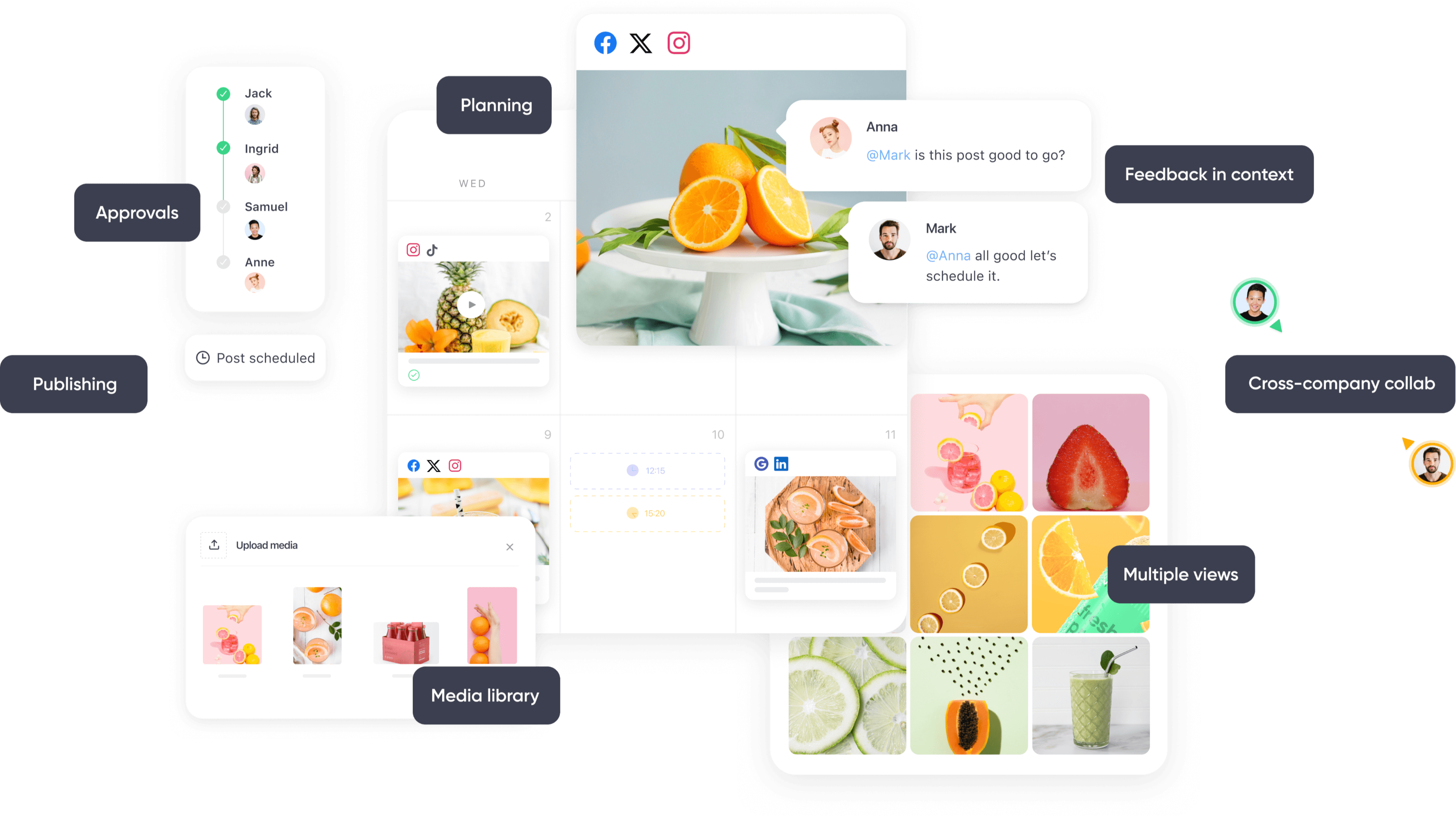

Planning, scheduling, approvals, feedback, cross-company collaboration & media library features in Planable
You can create workspaces dedicated to each team, client, or brand. Inviting external stakeholders is as easy as sending out an email invitation or shareable link — no account setup required.
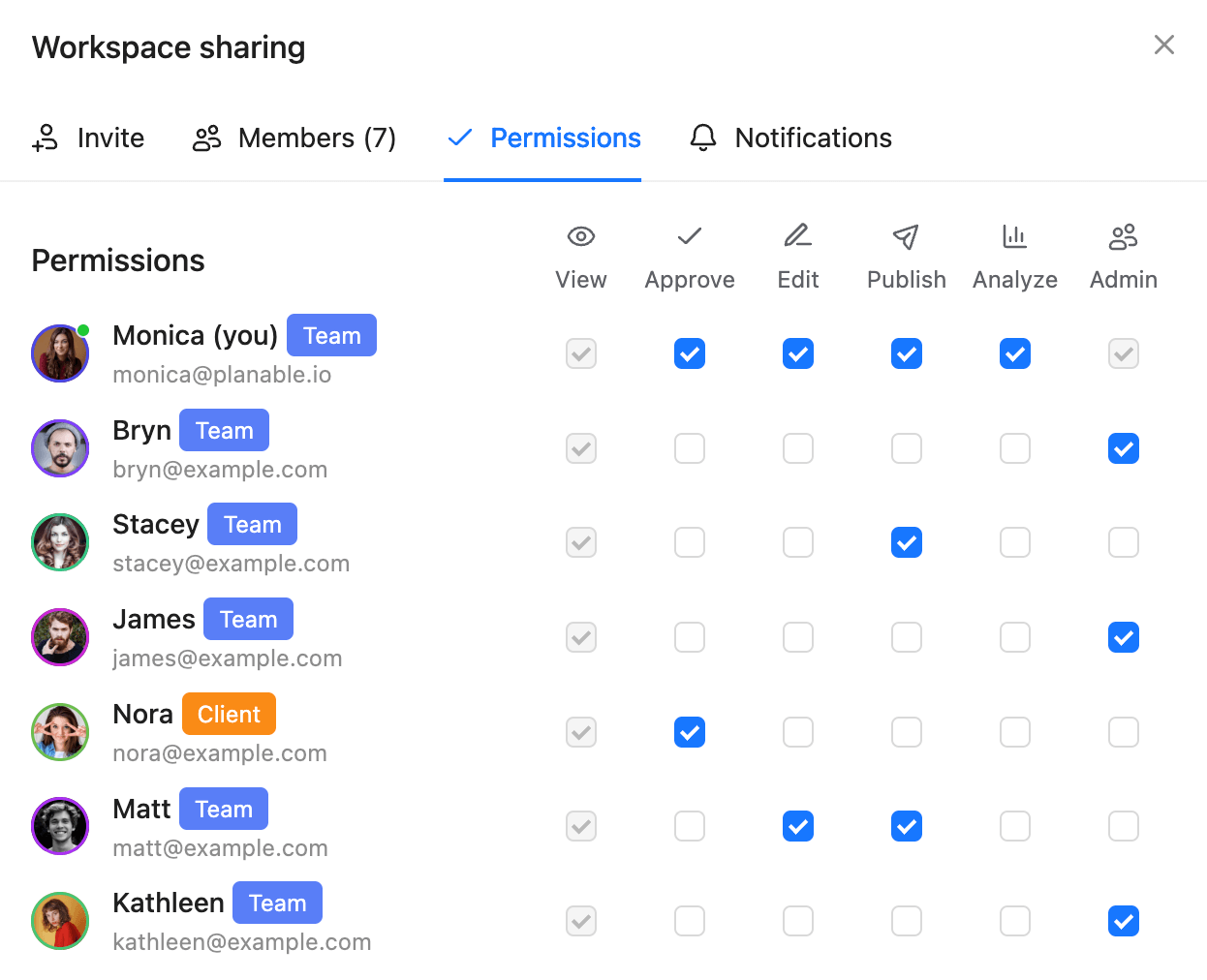

Workspace roles and permissions in Planable
Clients and team members can leave feedback on any content format (blogs, social posts, ad copy, videos, images, etc.) through in-context comments, text annotations, and suggestions. The option to mark comments — or entire posts — as internal is perfect for hiding work-in-progress content away from your client’s view.
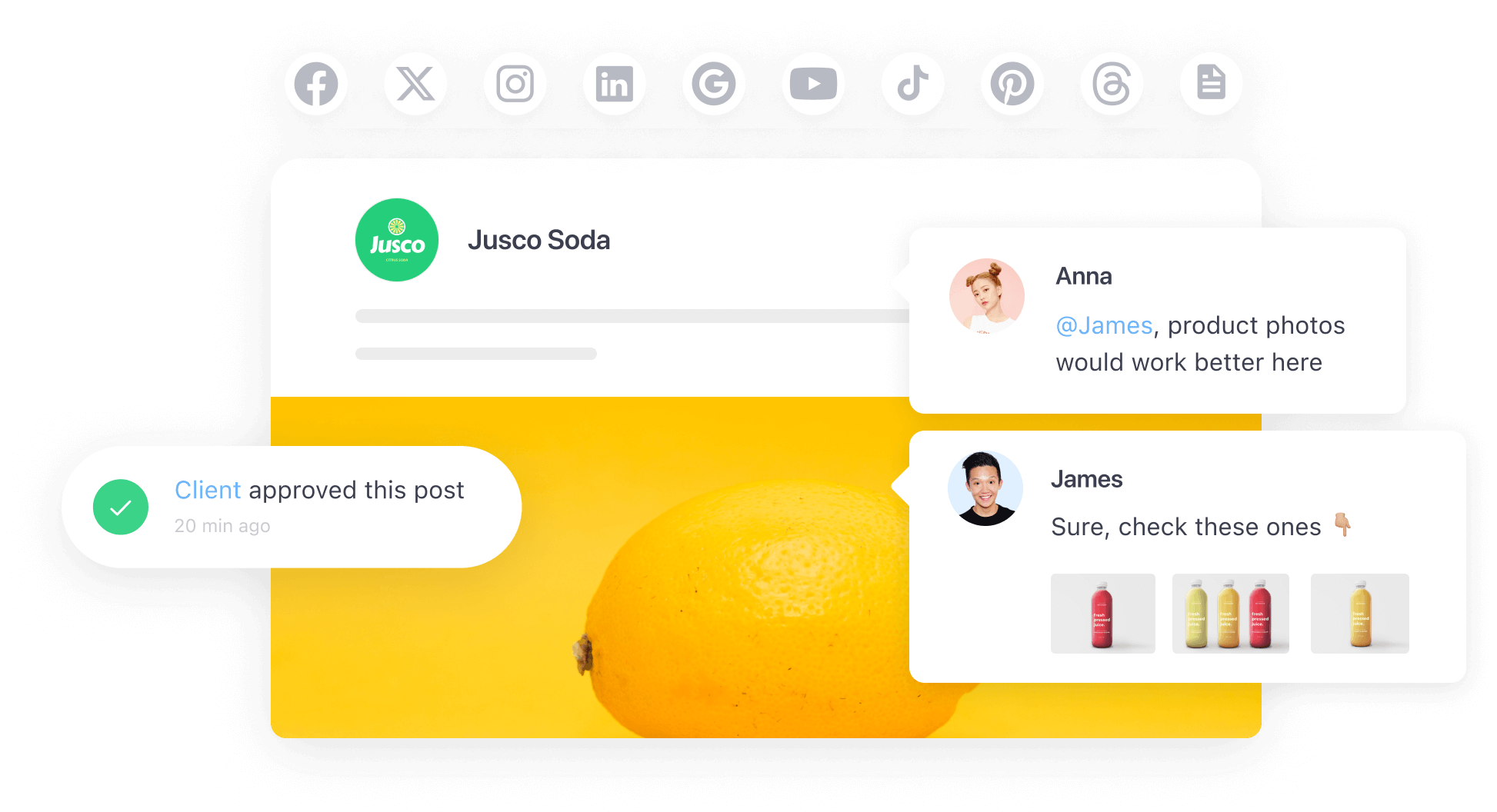

Content collaboration in Planable
Planable’s customizable approval workflows let you pick one of four workflow types: none, optional, required, and multi–level. Multi-level approvals ensure thorough review processes. You can set up as many approval levels as you like, while a project would have to pass through each distinct layer before reaching the final sign-off.


Multi-level approval workflow in Planable
For example, a blog post would first require approval by the lead editor, then it passes down to the content manager, while the client decides whether to give the green light. You can also automatically schedule content upon client approval.
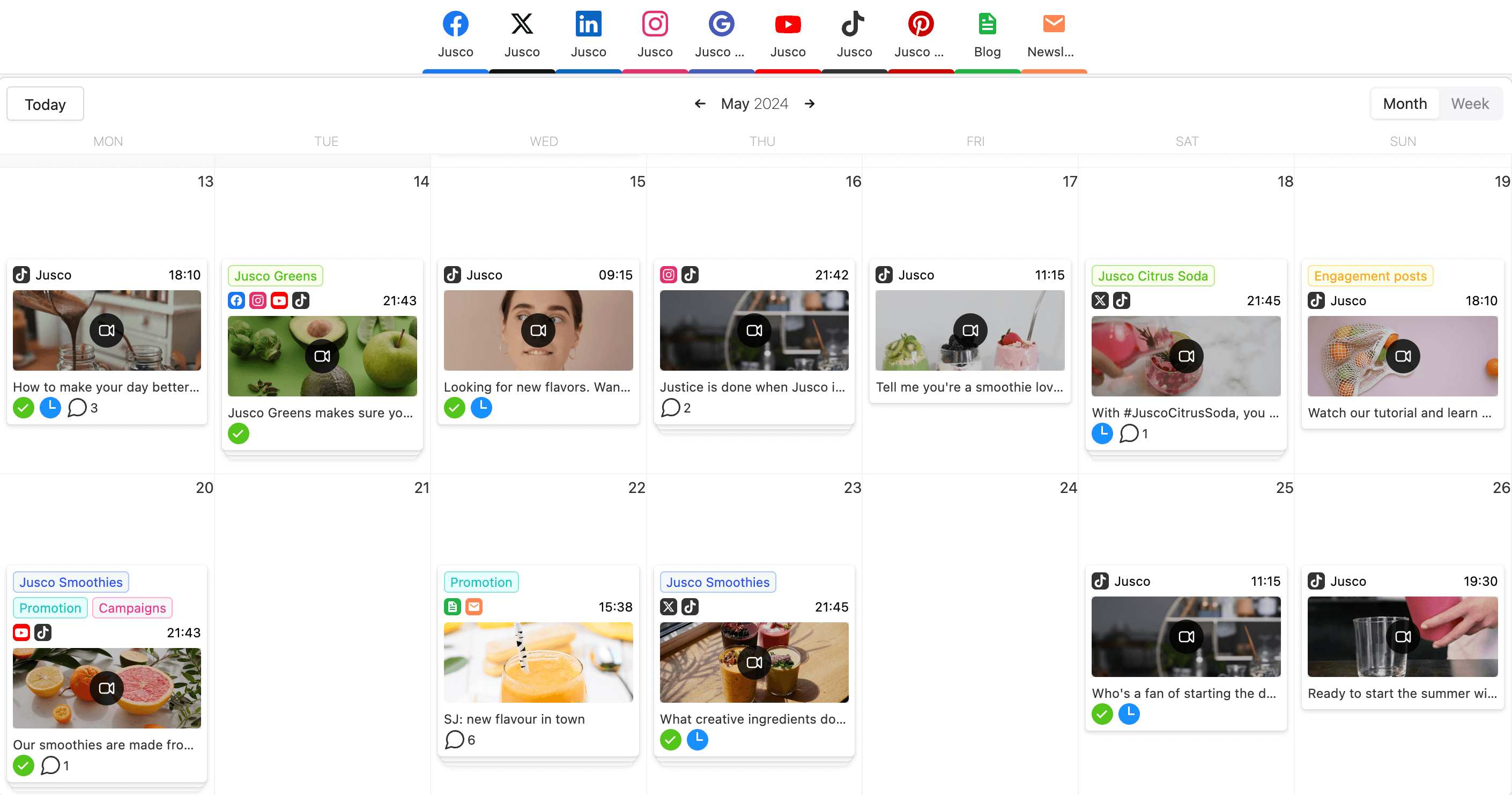

Content calendar view in Planable
As for social media management, you can schedule social media posts across all major social media networks (Threads included) via Planable’s straightforward calendar view. It also includes a dedicated Instagram grid view — perfect for planning Instagram-specific posts.
Key features
Schedule and re-schedule posts via a drag-and-drop interface. Organize content through color-coded labels, leave notes, and approve projects directly in the calendar with just a single click. Set up recurring and cross-network posts for social media.
Store digital assets in the platform’s media library. Edit and collaborate on images and videos through comments. Pick between multiple filters, adjust exposure, vignetting, and more.
- Custom user roles and permissions
Assign custom permissions to each team member and client, like viewer-only, approver, editor, publisher, or workspace admin.
Leverage the platform’s AI assistant to generate captions from scratch or tweak existing captions to make them longer or shorter or change their tone of voice.
- Analytics (optional add-on)
Track your social content’s performance (reach, engagement, impressions, etc.) across each specific network and analyze your follower base (location and gender distribution). Quickly generate reports and send them over to clients via email or shareable links.
Drawbacks: The platform lacks social media listening features.
Pricing: Planable lets you schedule your first 50 posts completely for free. Paid plans start at $33 per workspace per month (annual billing).
2. Hootsuite – best for social media analytics and reports
Hootsuite is an all-in-one social media management platform with particularly powerful analytics and reporting features.


You can stack your clients’ social media performance against their main competitors’ side-by-side based on key metrics like trending hashtags, posting frequency, highest-performing content formats, average engagement rates, and more.
Hootsuite also handles cross-network and network-specific reports, along with social media advertising performance analytics. Another stand-out is how easy it is to keep clients up-to-speed with their social performance — you can set up recurring exports to PDF, PPT, XLSX, and CSV files.
Key features
Pick between numerous ready-made reporting templates — from team productivity reports to industry benchmarking — or build your own custom reports from scratch.
Plan and schedule both organic and paid social media campaigns. Automatically turn boosted posts into sponsored content. Get ideal posting time and hashtag suggestions for maximum reach and engagement.
Monitor and respond to comments, DMs, and brand mentions from multiple networks under a unified inbox.
Drawbacks: Hootsuite is lackluster when it comes to team collaboration tools — it lacks in-context comments, annotations, text suggestions, and so on.
Pricing: Hootsuite starts at $99 per month (annual billing), with a free 30-day trial available.
3. Sprout Social – best for brand reputation management
Sprout Social is an all-in-one social media solution with highly capable customer service and review management features.
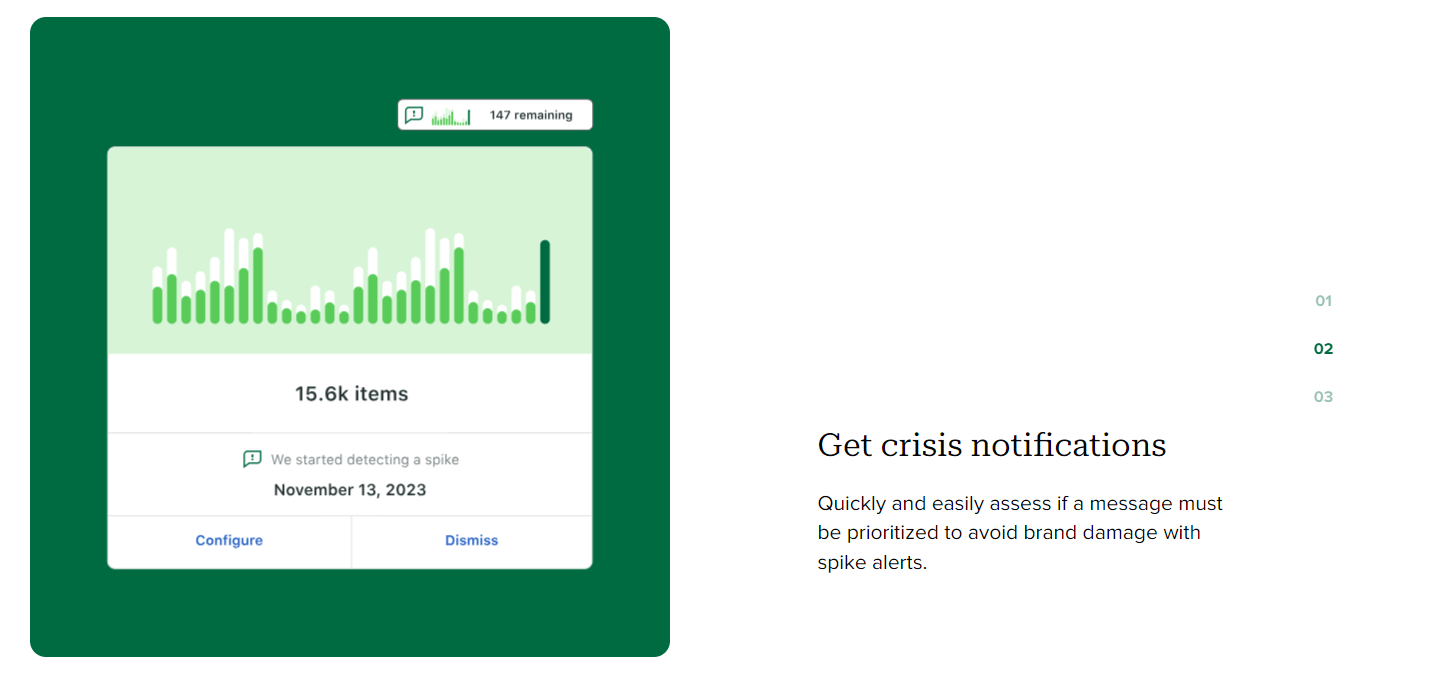

The platform lets you track and respond to customer reviews across the most popular review sites including Google Business Profile, Yelp, and Trustpilot, as well as monitor overall consumer sentiment via its dedicated Review Reports.
Sprout Social also includes a solid AI-powered social inbox. It displays all comments, DMs, and brand mentions under a unified inbox. You can then prioritize messages based on their sentiment (positive, negative, and neutral) to address critical feedback as quickly as possible.
Key features
- Social media customer service
Set up chatbots for your client’s Facebook and X accounts. Assign messages to specific team members and send AI-enhanced replies via built-in case management tools. Deploy CSAT and NPS surveys and store customer records in the platform’s dedicated Contacts view.
Search up specific phrases or keywords to find and get involved in customer conversations across the internet. Monitor review ratings and comments left on Facebook and Instagram advertisements.
Get notified whenever there’s a sudden surge of brand mentions to avoid potential PR crises.
Drawbacks: Despite its steep price tag, Sprout Social’s entry-level package lacks critical features — its media library, bulk scheduling, and Instagram grid planning are only available in up-tier plans.
Pricing: Sprout Social starts at $199 per user per month (annual billing). There’s a 30-day free trial available for all pricing packages (except Enterprise).
4. ClickUp – best for resource tracking and management
ClickUp is one of the best project management tools for agencies working with numerous clients. It’s an all-in-one project management platform with solid resource management capabilities.
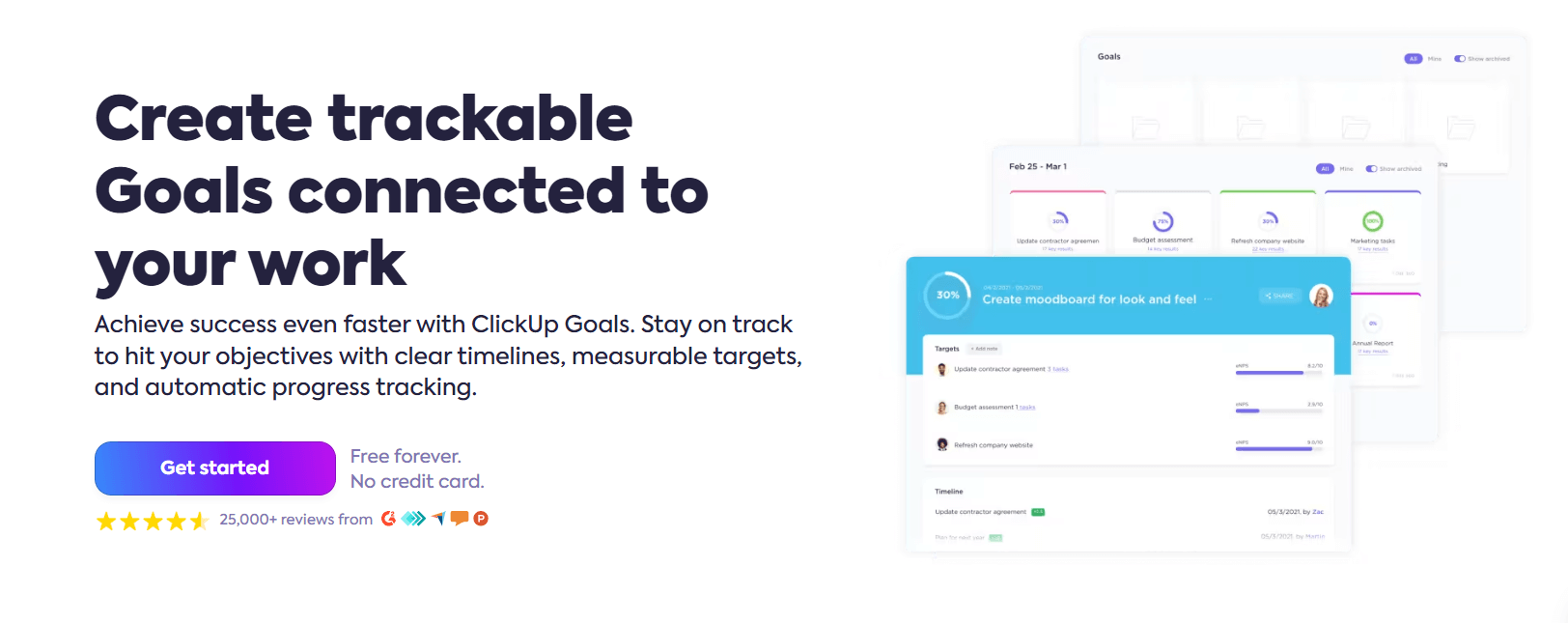

You can set up custom goals or targets for each project and track progress in real time through straightforward, visual interfaces.
Coupled with ClickUp’s native time tracking and workload management features, you can quickly redistribute resources from one client to the other whenever necessary.
Key features
Keep all your projects organized via Portfolios. Get a high-level overview of each project’s status and progress, then zoom in on the details to see all their corresponding tasks and assignees.
Split tasks into a series of sub-tasks or checklists to get a more granular approach to ongoing work. Set up task dependencies and priorities to ensure nothing falls through the cracks.
Communicate with team members through group chats and collaborative whiteboards. Collaborate on documents in real time and leverage the platform’s built-in file-proofing capabilities to let them review your work.
Drawbacks: ClickUp’s complexity gives it a bit of a learning curve.
Pricing: Paid packages start at $7 per user per month (annual billing), with a free version available.
5. Notion – best for client document management
Notion is an excellent option for organizing all your client’s brand guidelines, style guides, and branded assets within easy-to-navigate workspaces.
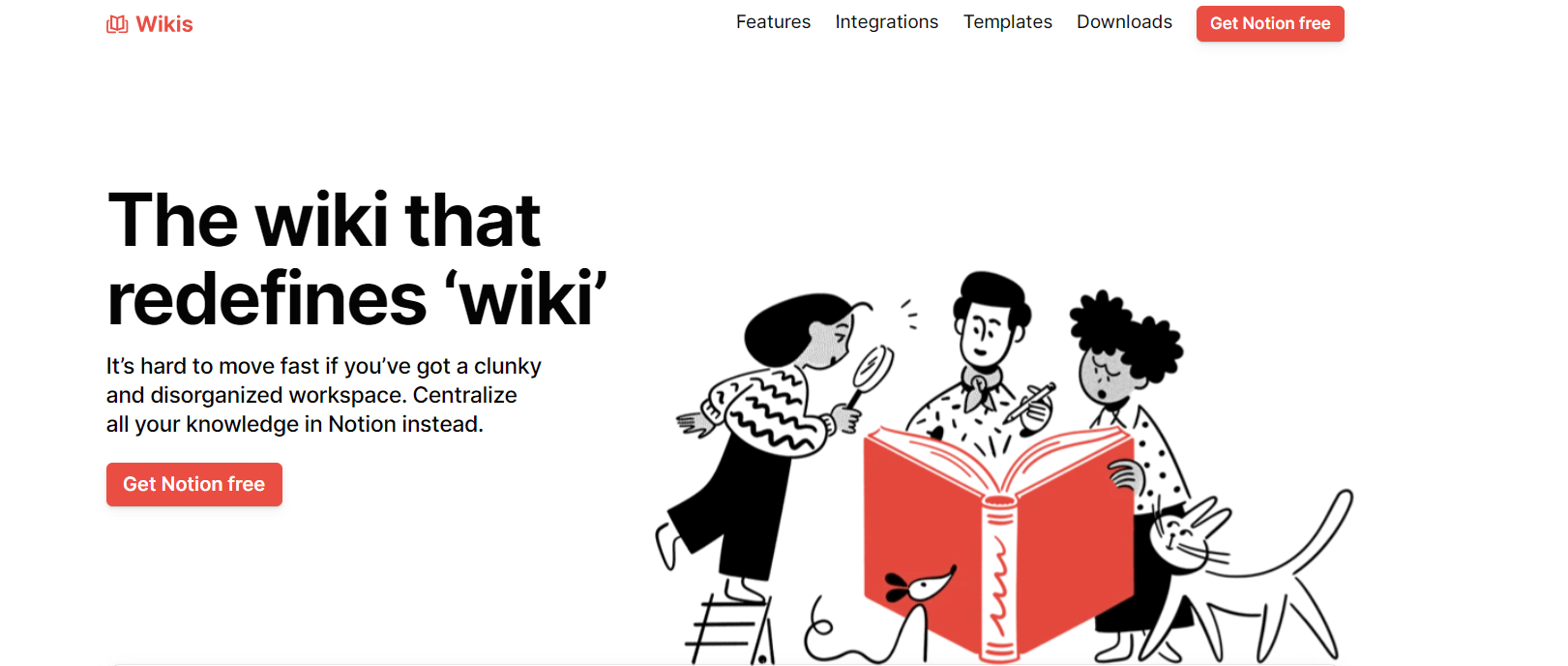

The platform lets you set up full-on wikis, complete with search bars, collapsible menus, and embedded digital assets, like videos and images. You can then publish these wikis under dedicated web pages — ideal for remote teams.
Key features
Organize ongoing work through tasks and sub-tasks. Use task dependencies and prioritize work based on urgency via color-coded labels and automatically assign tasks to specific team members.
Work on documents in real-time through in-context comments and annotations or centralize all communications via dedicated message inboxes. Easily invite clients to specific documents and set up public or private workspaces.
Automate workflows to minimize repetitive tasks, like project status updates, assigning tasks and due dates, or creating task summaries — all via a trigger-based workflow builder.
Drawbacks: Users report a rather steep initial learning curve.
Pricing: Paid plans start at $10 per user per month (annual billing), but there’s also a free version available.
6. Airtable – best for project reporting
Airtable is a spreadsheet-based project management tool with powerful reporting and analytics capabilities.


You can customize reports to show any data you want — from project progress and OKRs to resource allocation, budgets, and more — all through a low-code or no-code interface. The Interface Designer feature can also turn spreadsheet data into easy-to-digest, fully customized interactive interfaces.
Key features
Set up automatic workflows, like sending reports or approval requests to clients via Slack or email notifications, through a visual rule-based workflow builder.
Visualize ongoing projects through List, Kanban, Timeline, Gantt, Calendar views, and more. Easily track resource allocation across multiple teams via dedicated visual dashboards.
Store and organize media files with color-coded labels. Quickly find the appropriate assets through the platform’s file previews and broad filter selection.
Drawbacks: The platform is rather lackluster in the collaborative features department compared to the other project management software solutions on this list — it lacks built-in message inboxes, in-document comments, and so on.
Pricing: Airtable starts at $20 per user per month (annual billing). There’s also a free version available.
7. Canva – best for designing media assets
Canva is a graphics design tool that handles all sorts of assets — from logos to infographics, videos, visuals for social media, and even physical posters or flyers.
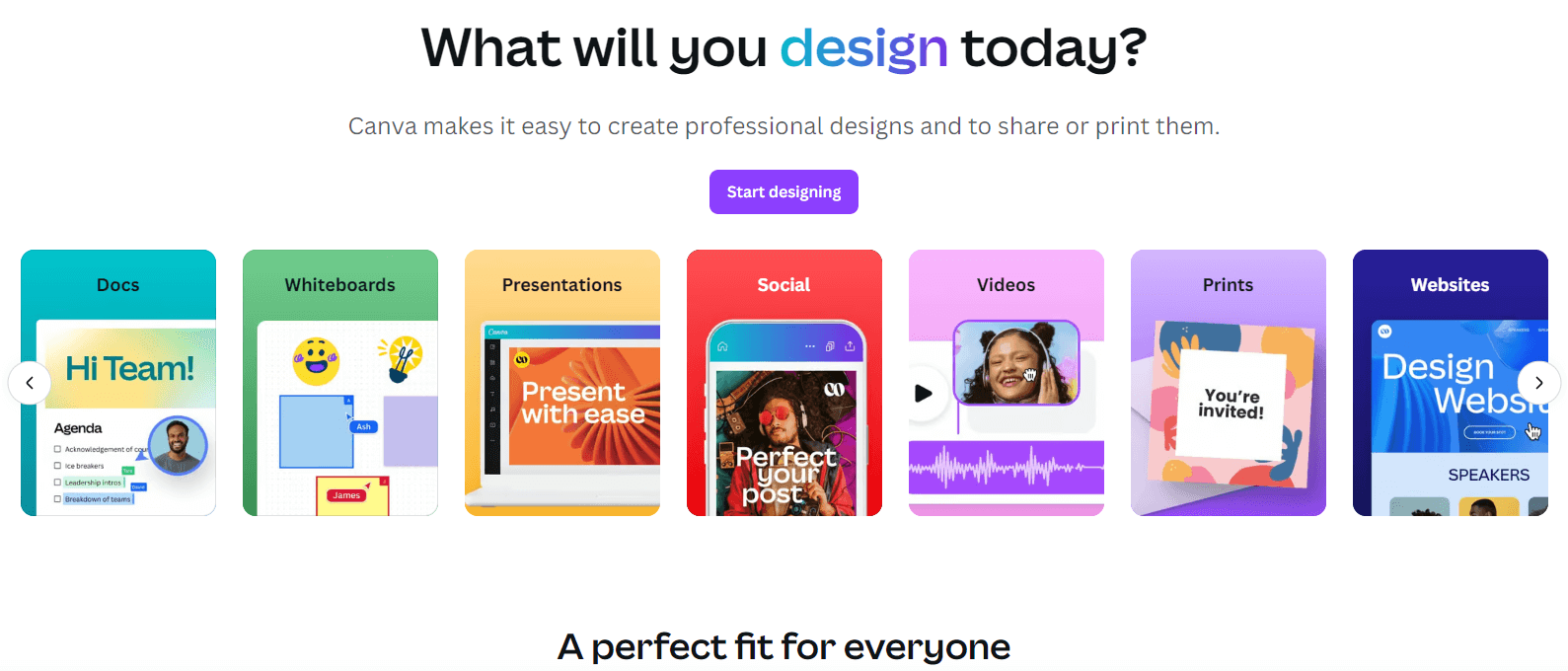

The platform also includes templates dedicated to presentations — perfect to showcase new ideas and strategies to your clients. External stakeholders can edit and leave feedback on digital assets via sharable links. As an added bonus, there’s a Planable integration that makes it super easy to export your designs from Canva so they’re ready to publish.
Key features
Automatically remove or replace image backgrounds, translate texts in up to 100 languages, and enhance audio quality with Canva’s AI-powered editing features — or generate completely new media assets from scratch through prompts.
Work with team members on media assets in real time. Collaborate through comments and assign dedicated approvers or groups of approvers.
Easily share files via email, social media, or other apps directly within the platform through Canva’s integrations — or export files as JPEGs, PDFs, and PNGs.
Drawbacks: Canva’s Team plan costs $100 per user per year (three users minimum). There’s also a free plan available.
Pricing: The platform’s free and Pro plans are strictly limited to one user.
8. Figma – best for prototyping and mockups
Figma is a collaborative graphic design and prototyping platform that helps design teams create wireframes for websites, mobile apps, and more, turn them into mockups, and expand on them until they become fully functional products.


The platform’s Handoff Components feature ensures seamless project transitions between design and development teams.
Key features
Leverage the Multiplayer feature to work on designs with multiple team members in real time (audio chat included). Get external stakeholders involved in the design process through Observation Mode — let them oversee your projects and leave comments in-canvas.
Build interactive prototypes complete with animations, videos, overlays, and transitions. Use conditional logic to simulate real-life interactions.
Mark prototypes as ready for development to ensure seamless hand-offs between design and dev teams. Allow devs to check visual elements along with their corresponding code side-by-side to minimize bugs and speed up the development process.
Drawbacks: Figma is resource-intensive and might cause occasional performance issues.
Pricing: Paid packages start at $15 per user per month. There’s also a free version available.
9. Miro – best for brainstorming and visual project planning
Miro is one of the best online collaboration tools for whiteboarding sessions. The platform includes dedicated templates for both brainstorming and diagramming so you can go from ideation straight to project planning.


Miro’s Intelligent Canvas also leverages AI-powered features to create summaries, sketch diagrams, and even pitch ideas in brainstorming sessions.
Key features
Collaborate with team members via the built-in video chat. Leverage Miro’s time tracker and voting systems to keep meetings organized.
Access numerous templates for technical diagramming, wireframing, mind mapping, and more — or build your own customized templates from scratch.
Showcase reports, documents, wireframes, and so on, to teams and clients. Let members move back and forth between slides to review or catch up with parts of the meeting. Get active feedback through comments and reactions.
Drawbacks: The free plan is quite limited — it lacks the option to invite external collaborations, track time, leave votes, and so on.
Pricing: Miro’s paid packages start at $8 per user per month (annual billing).
10. Slack – best for message-based communication
Slack is a straightforward message-based collaboration tool that lets team members and external stakeholders communicate via one-on-one messages and group chats.
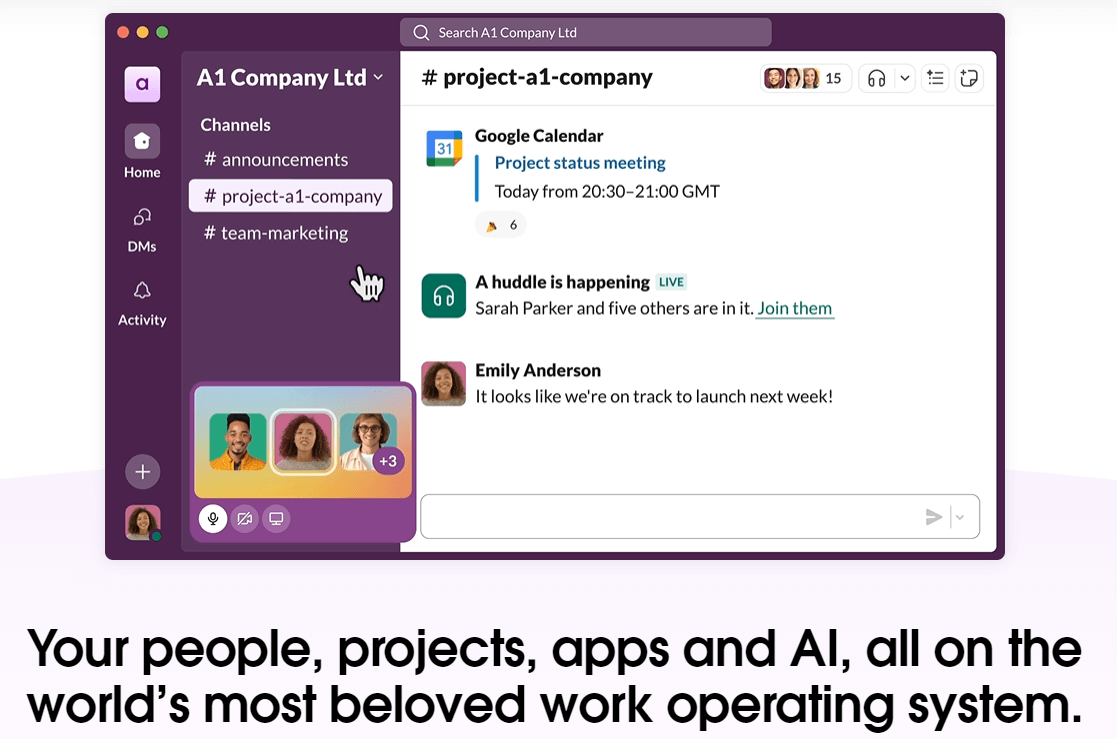

You can keep all of your work organized by creating separate channels for specific departments, projects, or any other topics, for example.
Key features
- Video and audio recording
Use the platform’s built-in recording tool to leave quick video or audio updates for your team.
Hold quick video or audio chat sessions directly within the platform. Record and annotate your screen in real time to better illustrate your points.
Create internal documents directly within the platform from scratch or via ready-made templates. Add checklists and embed files or visual elements like images, videos, and more.
Drawbacks: The free version only allows for one-on-one audio or video chats.
Pricing: There’s a free version available. Paid plans start at $7.25 per user per month (annual billing).
11. Zoom – best for client meetings and conference calls
Zoom is a collaboration tool that focuses on video meetings and conference calls. The platform’s free plan includes everything you need — video meetings of up to 40 minutes, built-in screen sharing and recording, as well as meeting notes.


Paid packages offer access to more advanced features like a meeting scheduler, polls, quizzes, and whiteboards for brainstorming sessions.
Key features
Collaborate with team members through one-on-one messaging, group chats, or dedicated channels. Keep track of your messaging history and find key conversations through the platform’s search bar and filters.
Use the platform’s built-in AI assistant to generate post-meeting summaries or translated call transcripts in real-time and create frameworks for your brainstorming sessions.
Set up internal wikis, project documents, and co-edit files in real time. Leverage the AI Companion to generate outlines — or fully-fledged documents.
Drawbacks: Users report that the interface is quite cluttered — some features may be hard to find.
Pricing: There’s a free version available, while paid plans start at $12.49 per user per month (annual billing).
Skip over unnecessary back-and-forths with client collaboration software
To recap, if you’re just looking for an alternative to emails for client collaboration, Slack and Zoom have you covered.
Airtable, ClickUp, and Notion are excellent choices for larger agencies seeking to manage projects at scale and keep work organized through task management and dependencies. Figma and Canva are great options for design and development teams, while Miro is a solid collaboration software solution for brainstorming and diagramming projects.
Planable, on the other hand, is an excellent client collaboration software for content marketing teams. The platform handles all sorts of written content, while the option to also schedule social media posts is a big plus. Its internal comments and posts, along with multi-level approvals ensure that work is as polished as possible before reaching the client.
So why not give it a shot? Try it for free here!

